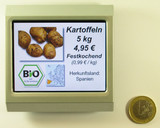Prices at the push of a button
Changing the prices on supermarket shelves often involves a lot of running around for the employees. A system of networked displays enables prices to be updated quickly and at any time from a central computer.
Sometimes you get a pleasant surprise at the checkout: T-shirt, camera or chocolate cost less than the price advertised on the shelf. Occasionally a product turns out to be more expensive. The few sales staff in electrical shops, DIY stores and supermarkets are usually overworked, and have very little time for updating the price tags on the shelves. Electronic displays are no easier to handle: If the price changes, the flash memory cards in the appropriate display have to be replaced.
In future, a networked electronic display system will save employees the trouble of running around to change price tags – and customers will be spared the surprises. Researchers at the Fraunhofer Institute for Microelectronic Circuits and Systems IMS in Duisburg have developed these networked displays in collaboration with a commercial company, renzel media. “The store manager can quickly and easily change the prices on the displays via a central computer in the office,” explains IMS team leader Hans-Christian Müller. “To make this possible, we have integrated a receiver in each screen. Each display can be separately controlled via a transmitter in the central computer.” If strawberries are on special offer, for instance, the store manager only needs to copy the file containing the new price into the main directory – and the price displayed on the strawberry shelf is instantly updated. To ensure that the price is changed on the correct display screen, the name of this file is the numerical code of the appropriate display. The software for creating the price tags is part of the package delivered by renzel media.
The computer splits up the image to be displayed – such as a punnet of strawberries with the respective price – into small data packages which it transmits to the receiver. The receiver pieces the image together again and displays it. If a data package is lost during the radio transmission, the receiver automatically sends a query to the transmitter, and the missing package is sent again. There is a good reason for these data packages: The displays only have a very small processor so that they can operate with a minimum of energy and do not generate too much heat. “This means it is even possible to use tightly sealed casings, which is an advantage in certain places where displays are installed – for instance in refrigerated shelves where moisture is unavoidable,” says Müller. The prototype of the networked display system with 25 displays can be seen at the Hannover Messe on April 21 through 25 (Hall 6, Stand K10). The researchers are now planning to scale up their development for serial production.
Download:
Contact:
Dipl.-Ing. Martin van Ackeren
Phone: +49 203-3783-130
Email: martin.van.ackeren(at)ims.fraunhofer.de
Fraunhofer-Institut für Mikroelektronische Schaltungen und Systeme IMS
Finkenstraße 61
47057 Duisburg
Germany
